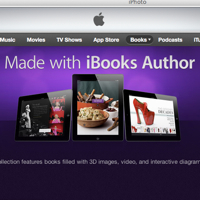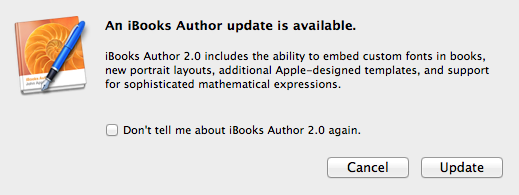Note: Since I first publishing this post, I took the leap and updated to iBA 2.0. (Of course, I had to because iTunes only accepts new books created in iBA 2.) I published three books in the new software and was also able to successfully open iBA 1.0 files in 2.0 and even copy widgets and other content from 1.0 to 2.0.
Over the last few months I’ve been blogging regularly about my iBooks Author (iBA) learning curve and the production of my first iBook. Along the way I have come to rely on the advice of Dr. Frank Lowney Projects Coordinator, Digital Innovation Group @ Georgia College.
BTW – Frank published The Coming ePublishing Revolution in Higher Education on iTunes. It’s an insightful guide to etextbook revolution – winners, losers, and the factors that will determine the outcome. (67 pages, 20 graphics, 28 media files, 25 video files and 5 interactive widgets.) A bargain at only $0.99!
Frank’s been most generous with his time and advice on technical aspects of formatting videos for use in iBooks Author. Recently he contacted me about some troubling features in the new iBA 2.0 which I summarized in a post – Read This Before You Upgrade to iBooks Author 2.0. As a result of that post, I was contacted by Jay Welshofer (Apple’s Senior Product Manager for iBooks Author and Keynote) who has been working with Frank to better understand the video encoding issues with iBA 2.0.
Rather than expose my veneer of understanding of video technology, let me quote some of my correspondence with Frank so that others can benefit.
I begin with three questions I posed to Frank about iBA 2.0 video optimizer ~ Frank’s replies:
1. Does it do an acceptable job on quality? (a bit of a change from your earlier appraisal)
~ Yes, the quality is quite good if the source is good. I haven’t yet done a lot of testing with lower quality source but that’s on the todo list.
2. Does it increase file size ?
~ Absolutely. The bloat is up to three times the size of what Handbrake outputs with no appreciable difference in video quality.
3. Does it wipe out subtitle tracks
~ Every time. Alternate audio tracks and chapter tracks too. Of course, chapter tracks are not relevant to iOS video except in the Videos.app which has an interface for chapters that is separate from playback. Older versions of quicktime presented chapters as a drop down menu in the controller which lends itself to all kinds of neat pedagogical uses.
To reinforce his point Frank ran a test video conversion comparing iBA 2.0 and Handbrake and supplied a video sample of each. He writes:
Dear Peter and Jay,
I have been unable to reliably replicate my initial report where video quality was significantly lessened by the IBA media optimizer. Actually, this optimizer does a pretty good job of maintaining video quality no matter what you throw at it.
However, there is still the problem of file size bloat that started this whole line of investigation back in the IBA v1 days. As you’ll recall, IBA would reject many videos and recommend re-encoding in QuickTime Player and that would create files 2-3 times larger. This was a concern to many IBA users due to the 2 GB limit on iBooks in the iBookstore.
Back then, the workaround was to tweak the output of more efficient systems such as Handbrake such that IBA wouldn’t reject them. Now, with IBA v2, the use of QuickTime is no longer optional and the file size bloat issue is with us again. The new workaround is to use the video replacement surgery tactic that I described earlier. It’s a bit more daunting than the earlier workaround because you could break the whole iBook just by getting the name of one video file wrong, a typo for example.
As promised, I’ve constructed a hardball case documenting this issue as follows. An executive summary in the form of a screencast comparing the iBooks Author encode to the Handbrake encode will have more general interest. Here it is:
The source file came from a “pro” level HD DV camera and was provided to us as a ~16 GB DVCPRO HD file at 720p. As you can see from the video, iBooks Author encoded this as a 1.5 GB file (causing a warning about the 2 GB limit) whereas Handbrake 0.98 (Apple TV 3 preset) produced a 532 MB file, a third of what IBA produced. Also evident in the video should be the fact that there is no discernible difference in size or quality.
BTW, I used QuickTime Player 7.6 for this demo because it can play two or more videos sychronously allowing much better qualitative analysis. QuickTime X Player cannot do this.



Hello.
When I look at my iBooks author program I still have version 1 so I’m curious how to tweak the settings in Handbrake to be able to use the video file directly from Handbrake (and not running it through Quicktime player) in iBooks author?
I would like to add two films in my iBook but with Quicktime enlargening the file so much it’s not possible. If I could use the file created through Handbrake that would be perfect. If that’s possible?
Thank you!
Hi Hanna,
iBA 1.0 does not accept Handbreak converted video. Even with “tweeks” to settings.
And you are correct, that QT will increase file size. Thus when made my first iBook using iBA 1.0 I did the file conversion with Compressor. (unfortunately – that costs $50).
I now have a second machine running iBA 2.0. Later this morning (it’s 3:30 AM here) I’ll see if iBA 2.0 accepts Handbreak conversions. Haven’t tried that yet in that program. I’ll get back to you. Cheers – heading off to sleep
Hi Hanna,
I had a chance to test Handbrake on iBA 2.0.
Good news is that unlike iBA 1.0 which refused m4v conversions using Handbrake, iBA 2.0 plays nice with Handbrake.
I ran a test starting with a 4.1MB mp4 video. Handbrake converted it to a 5.8MB m4v that was accepted into iBA 2.0 and ran nicely when I previewed on my iPad. In contrast when I used QuickTime to convert the same 4.1MB mp4 video, QT produced a 9MB m4v.
Another thing to remember about iBA 2.0 is that if you want upload the finished ibook to iTunes, it’s now a requirement to make use iBA 2.0.
Thanks for calling this whole matter into question. I think it’s time I updated this post.
I’m a complete newbie to digital publishing and ibook author. I’m having trouble finding out how the files, once in itunes are protected from being copied. I have a series of comic books that are available in english and french, in two different language levels, for 10 year olds who are either learning a second language or having difficulty with reading.
Thank you
HI Stephen,
According to Apple “Books submitted to the iBooks Store using a Paid Books Account can be protected by Apple’s proprietary FairPlay DRM (digital rights management) system, which helps prevent unauthorized duplication of your book. (Movies and audio included in HTML5 widgets are not DRM-protected.)”
It’s my understanding that while there apps that will remove DRM from various formats , but not from Apple epubs. Apple uses their own DRM called Fair Play.
Having said that, I’m sure someone is working to crack that as I type.
Hope that helps.
Peter
I’m having a problem in that when I place my images into ibooks author, they seem to have plenty of resolution to spare, and a sharp image when magnified. However, when I preview the book, it is not as sharp. This is a problem because my text is actually part of the art, and not “live” text. Is this just a problem with the preview? I haven’t been able to view it on an ipad yet.
Thanks,
Stephen